Page 1 of 3502
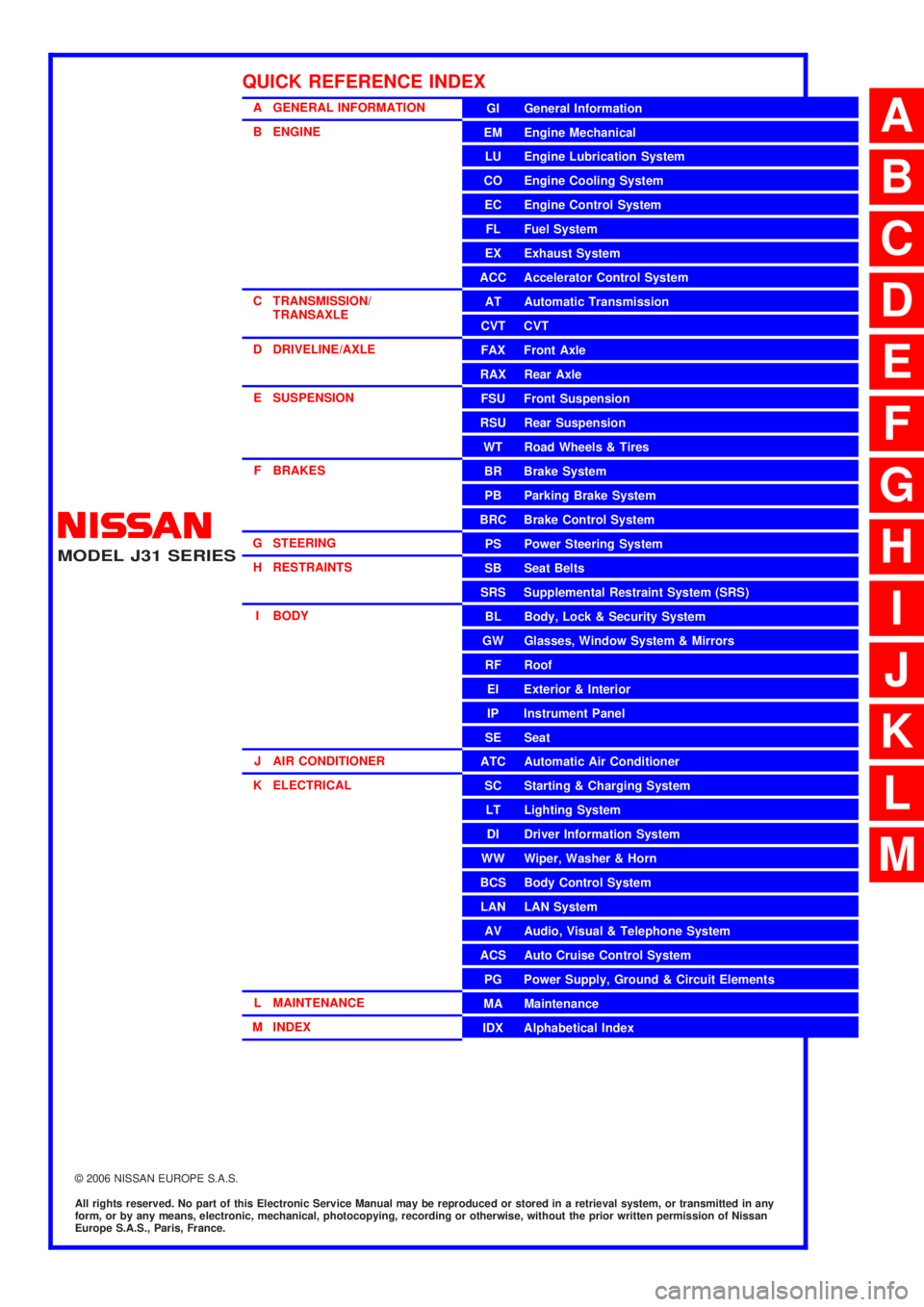
MODEL J31 SERIES
2006 NISSAN EUROPE S.A.S.
All rights reserved. No part of this Electronic Service Manual may be reproduced or stored in a retrieval system, or transmitted in any
form, or by any means, electronic, mechanical, photocopying, recording or otherwise, without the prior written permission of Nissan
Europe S.A.S., Paris, France.
A GENERAL INFORMATION
B ENGINE
C TRANSMISSION/TRANSAXLE
D DRIVELINE/AXLE
E SUSPENSION
F BRAKES
G STEERING H RESTRAINTS
I BODY
J AIR CONDITIONER
K ELECTRICAL
L MAINTENANCE
M INDEXGI General Information
EM Engine Mechanical
LU Engine Lubrication System
CO Engine Cooling System
EC Engine Control System
FL Fuel System
EX Exhaust System
ACC Accelerator Control System
AT Automatic Transmission
CVT CVT
FAX Front Axle
RAX Rear Axle
FSU Front Suspension
RSU Rear Suspension
WT Road Wheels & Tires
BR Brake System
PB Parking Brake System
BRC Brake Control System
PS Power Steering System
SB Seat Belts
SRS Supplemental Restraint System (SRS)
BL Body, Lock & Security System
GW Glasses, Window System & Mirrors
RF Roof
EI Exterior & Interior
IP Instrument Panel
SE Seat
ATC Automatic Air Conditioner
SC Starting & Charging System
LT Lighting System
DI Driver Information System
WW Wiper, Washer & Horn
BCS Body Control System
LAN LAN System
AV Audio, Visual & Telephone System
ACS Auto Cruise Control System
PG Power Supply, Ground & Circuit Elements
MA Maintenance
IDX Alphabetical Index
QUICK REFERENCE INDEX
A
B
C
D
E
F
G
H
I
J
K
L
M
Page 3 of 3502
ACC-1
ACCELERATOR CONTROL SYSTEM
B ENGINE
CONTENTS
C
D
E
F
G
H
I
J
K
L
M
SECTION ACC
A
ACC
ACCELERATOR CONTROL SYSTEM
PRECAUTIONS .......................................................... 2
Precautions for Supplemental Restraint System
(SRS) “AIR BAG” and “SEAT BELT PRE-TEN-
SIONER” .................................................................. 2ACCELERATOR CONTROL SYSTEM ....................... 3
Removal and Installation .......................................... 3
REMOVAL ............................................................. 3
INSTALLATION ..................................................... 3
INSPECTION AFTER INSTALLATION .................. 3
Page 5 of 3502
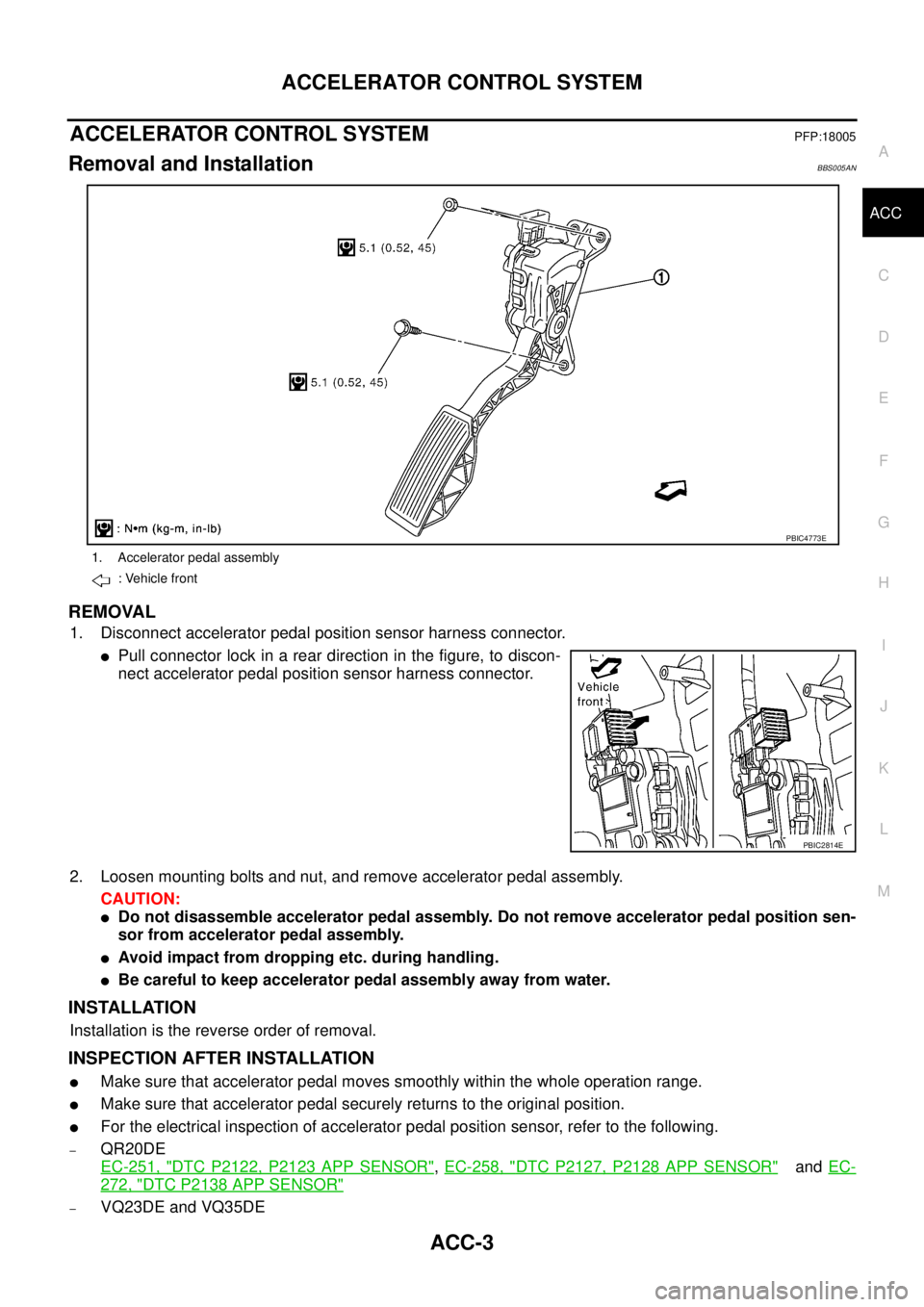
ACCELERATOR CONTROL SYSTEM
ACC-3
C
D
E
F
G
H
I
J
K
L
MA
ACC
ACCELERATOR CONTROL SYSTEMPFP:18005
Removal and InstallationBBS005AN
REMOVAL
1. Disconnect accelerator pedal position sensor harness connector.
�Pull connector lock in a rear direction in the figure, to discon-
nect accelerator pedal position sensor harness connector.
2. Loosen mounting bolts and nut, and remove accelerator pedal assembly.
CAUTION:
�Do not disassemble accelerator pedal assembly. Do not remove accelerator pedal position sen-
sor from accelerator pedal assembly.
�Avoid impact from dropping etc. during handling.
�Be careful to keep accelerator pedal assembly away from water.
INSTALLATION
Installation is the reverse order of removal.
INSPECTION AFTER INSTALLATION
�Make sure that accelerator pedal moves smoothly within the whole operation range.
�Make sure that accelerator pedal securely returns to the original position.
�For the electrical inspection of accelerator pedal position sensor, refer to the following.
–QR20DE
EC-251, "
DTC P2122, P2123 APP SENSOR", EC-258, "DTC P2127, P2128 APP SENSOR" and EC-
272, "DTC P2138 APP SENSOR"
–VQ23DE and VQ35DE
1. Accelerator pedal assembly
: Vehicle front
PBIC4773E
PBIC2814E
Page 6 of 3502
ACC-4
ACCELERATOR CONTROL SYSTEM
EC-631, "DTC P2122, P2123 APP SENSOR", EC-638, "DTC P2127, P2128 APP SENSOR" and EC-
652, "DTC P2138 APP SENSOR"
CAUTION:
�When harness connector of accelerator pedal position sensor is disconnected, perform “Acceler-
ator Pedal Released Position Learning”. Refer to the following.
–QR20DE
EC-47, "
Accelerator Pedal Released Position Learning"
–VQ23DE and VQ35DE
EC-389, "
Accelerator Pedal Released Position Learning"
Page 34 of 3502
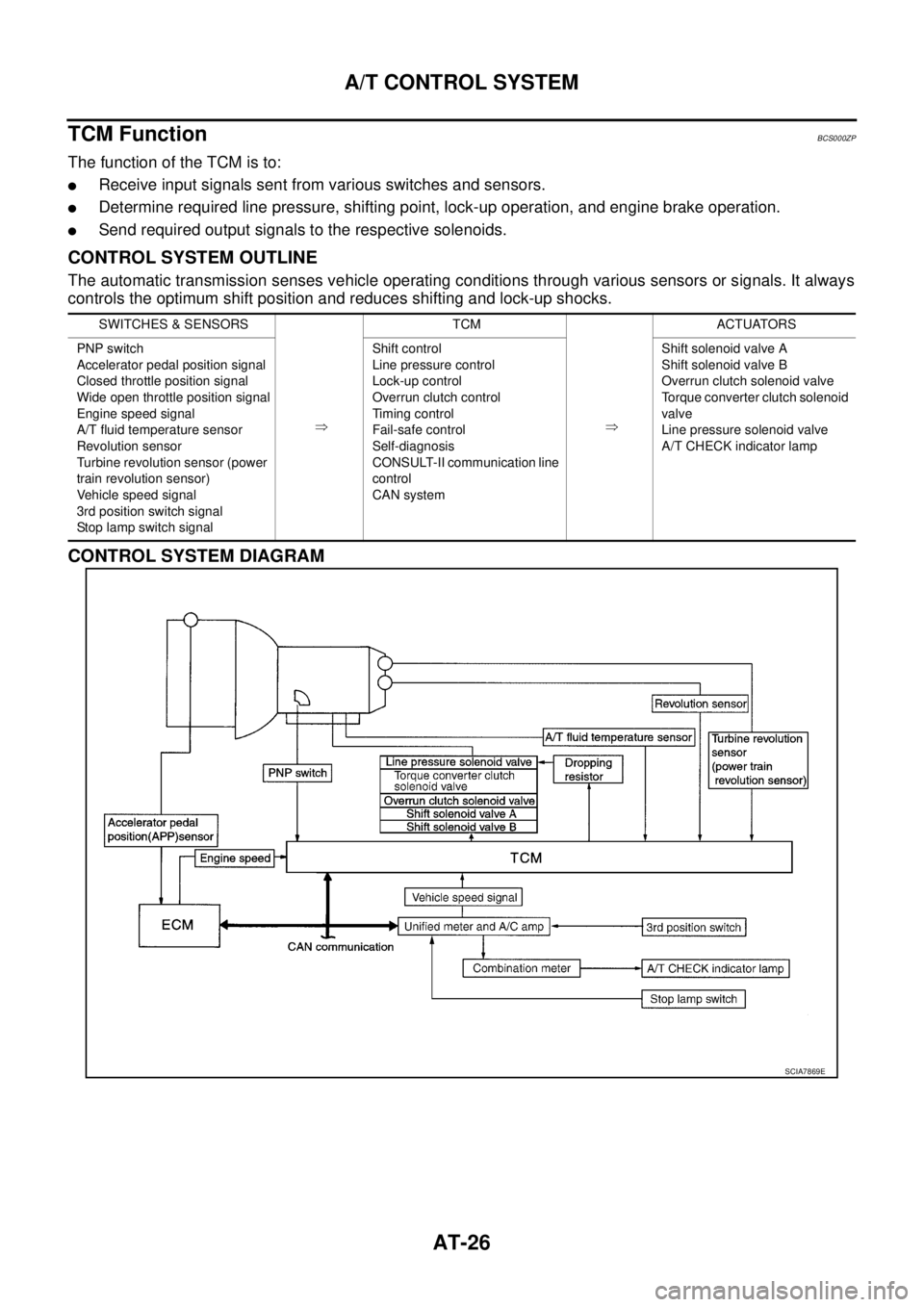
AT-26
A/T CONTROL SYSTEM
TCM FunctionBCS000ZP
The function of the TCM is to:
�Receive input signals sent from various switches and sensors.
�Determine required line pressure, shifting point, lock-up operation, and engine brake operation.
�Send required output signals to the respective solenoids.
CONTROL SYSTEM OUTLINE
The automatic transmission senses vehicle operating conditions through various sensors or signals. It always
controls the optimum shift position and reduces shifting and lock-up shocks.
CONTROL SYSTEM DIAGRAM
SWITCHES & SENSORS
�TCM
�ACTUATORS
PNP switch
Accelerator pedal position signal
Closed throttle position signal
Wide open throttle position signal
Engine speed signal
A/T fluid temperature sensor
Revolution sensor
Turbine revolution sensor (power
train revolution sensor)
Vehicle speed signal
3rd position switch signal
Stop lamp switch signalShift control
Line pressure control
Lock-up control
Overrun clutch control
Timing control
Fail-safe control
Self-diagnosis
CONSULT-II communication line
control
CAN systemShift solenoid valve A
Shift solenoid valve B
Overrun clutch solenoid valve
Torque converter clutch solenoid
valve
Line pressure solenoid valve
A/T CHECK indicator lamp
SCIA7869E
Page 35 of 3502

A/T CONTROL SYSTEM
AT-27
D
E
F
G
H
I
J
K
L
MA
B
AT
CAN CommunicationBCS000ZQ
SYSTEM DESCRIPTION
CAN (Controller Area Network) is a serial communication line for real time application. It is an on-vehicle mul-
tiplex communication line with high data communication speed and excellent error detection ability. Many elec-
tronic control units are equipped onto a vehicle, and each control unit shares information and links with other
control units during operation (not independent). In CAN communication, control units are connected with 2
communication lines (CAN H line, CAN L line) allowing a high rate of information transmission with less wiring.
Each control unit transmits/receives data but selectively reads required data only. For details, refer to LAN-49,
"CAN System Specification Chart" .
Input/Output Signal of TCMBCS000ZR
*1: Spare for vehicle speed sensor·A/T (revolution sensor)
*2: Spare for accelerator pedal position signal
*3: If these input and output signals are different, the TCM triggers the fail-safe function.
*4: Used as a condition for starting self-diagnostics; if self-diagnostics are not started, it is judged that there is some kind of error.
*5: Input by CAN communications.
*6: Output by CAN communications.Control itemLine
pressure
controlVehicle
speed
controlShift
controlLock-up
controlEngine
brake
controlFail-safe
functionSelf-diag-
nostics
function
InputAccelerator pedal position signal
(*5)XXXXX(*3) XX
Vehicle speed sensor A/T
(Revolution sensor)XXXXX(*3) XX
Vehicle speed sensor MTR
(*1)XXXX X
Closed throttle position signal
(*5)(*2) X(*2) XXX(*4) X
Wide open throttle position signal
(*5)(*2) X (*2) X (*4) X
Turbine revolution sensor (Power
train revolution sensor)XX X XX
Engine speed signal X X X X
PNP switch XXXXX(*3) X(*4) X
Stop lamp switch signal
(*5)XX (*4) X
A/T fluid temperature sensors X X X X X X
3rd position switch signal
(*5)XXXX (*4) X
TCM power supply voltage signal X X X X
Out-
putShift solenoid valve A/B X (*3) X X
Line pressure solenoid X (*3) X X
Torque converter clutch solenoid
valveX(*3) XX
Overrun clutch solenoid valve X X (*3) X X
A/T CHECK indicator lamp
(*6)X
Page 37 of 3502
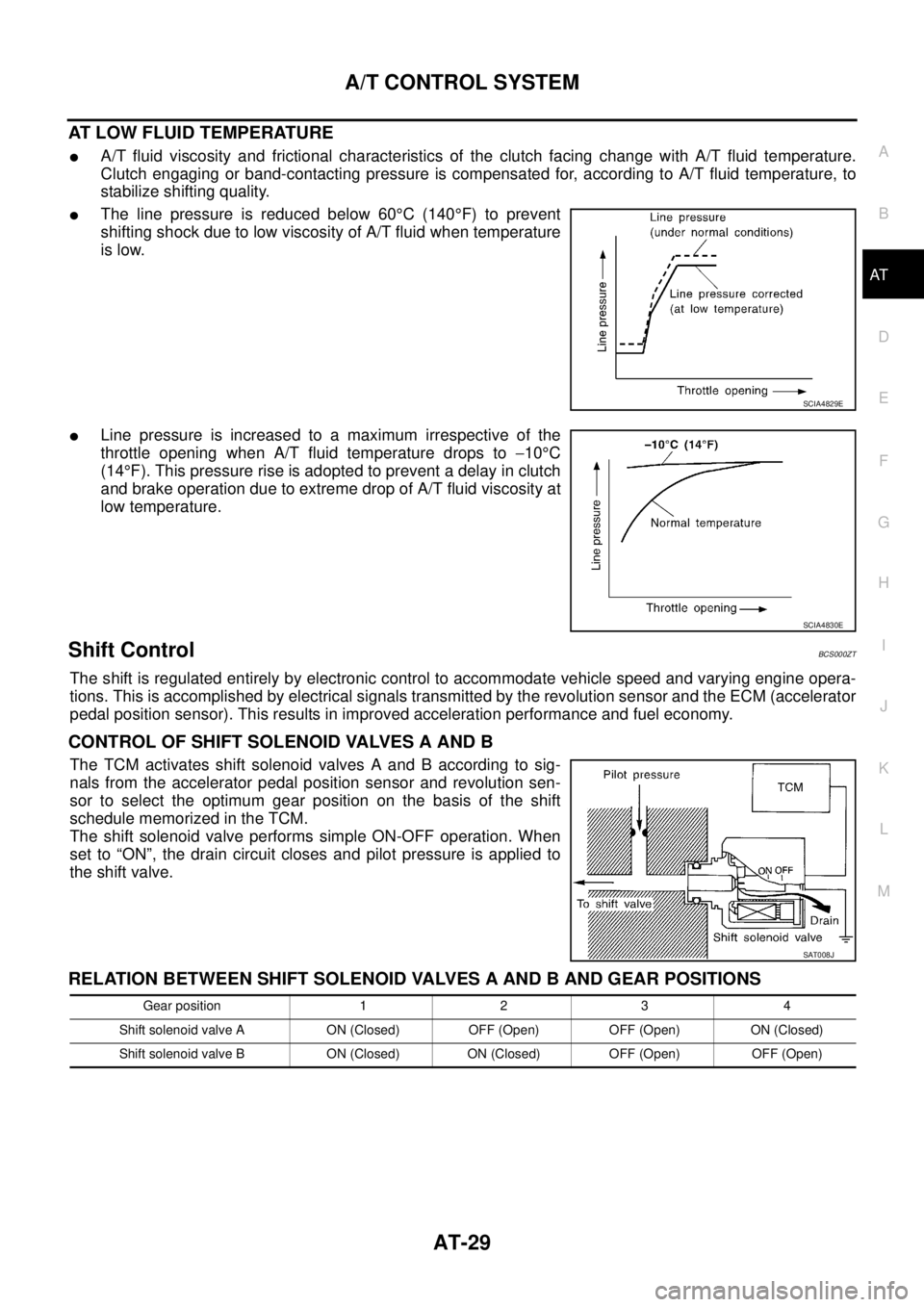
A/T CONTROL SYSTEM
AT-29
D
E
F
G
H
I
J
K
L
MA
B
AT
AT LOW FLUID TEMPERATURE
�A/T fluid viscosity and frictional characteristics of the clutch facing change with A/T fluid temperature.
Clutch engaging or band-contacting pressure is compensated for, according to A/T fluid temperature, to
stabilize shifting quality.
�The line pressure is reduced below 60°C (140°F) to prevent
shifting shock due to low viscosity of A/T fluid when temperature
is low.
�Line pressure is increased to a maximum irrespective of the
throttle opening when A/T fluid temperature drops to −10°C
(14°F). This pressure rise is adopted to prevent a delay in clutch
and brake operation due to extreme drop of A/T fluid viscosity at
low temperature.
Shift ControlBCS000ZT
The shift is regulated entirely by electronic control to accommodate vehicle speed and varying engine opera-
tions. This is accomplished by electrical signals transmitted by the revolution sensor and the ECM (accelerator
pedal position sensor). This results in improved acceleration performance and fuel economy.
CONTROL OF SHIFT SOLENOID VALVES A AND B
The TCM activates shift solenoid valves A and B according to sig-
nals from the accelerator pedal position sensor and revolution sen-
sor to select the optimum gear position on the basis of the shift
schedule memorized in the TCM.
The shift solenoid valve performs simple ON-OFF operation. When
set to “ON”, the drain circuit closes and pilot pressure is applied to
the shift valve.
RELATION BETWEEN SHIFT SOLENOID VALVES A AND B AND GEAR POSITIONS
SCIA4829E
SCIA4830E
SAT008J
Gear position 1 2 3 4
Shift solenoid valve A ON (Closed) OFF (Open) OFF (Open) ON (Closed)
Shift solenoid valve B ON (Closed) ON (Closed) OFF (Open) OFF (Open)
Page 38 of 3502
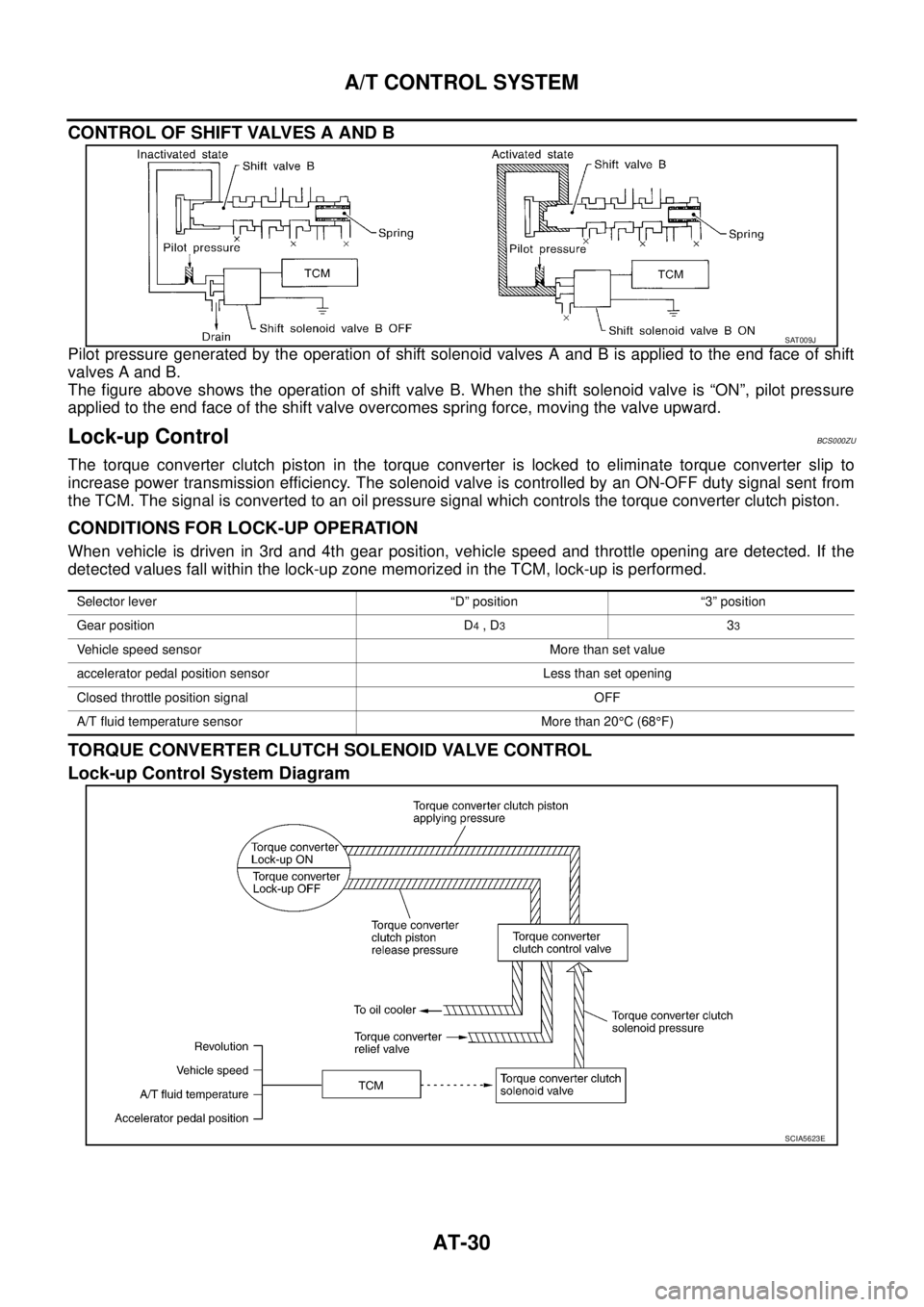
AT-30
A/T CONTROL SYSTEM
CONTROL OF SHIFT VALVES A AND B
Pilot pressure generated by the operation of shift solenoid valves A and B is applied to the end face of shift
valves A and B.
The figure above shows the operation of shift valve B. When the shift solenoid valve is “ON”, pilot pressure
applied to the end face of the shift valve overcomes spring force, moving the valve upward.
Lock-up ControlBCS000ZU
The torque converter clutch piston in the torque converter is locked to eliminate torque converter slip to
increase power transmission efficiency. The solenoid valve is controlled by an ON-OFF duty signal sent from
the TCM. The signal is converted to an oil pressure signal which controls the torque converter clutch piston.
CONDITIONS FOR LOCK-UP OPERATION
When vehicle is driven in 3rd and 4th gear position, vehicle speed and throttle opening are detected. If the
detected values fall within the lock-up zone memorized in the TCM, lock-up is performed.
TORQUE CONVERTER CLUTCH SOLENOID VALVE CONTROL
Lock-up Control System Diagram
SAT009J
Selector lever “D” position “3” position
Gear position D
4 , D333
Vehicle speed sensor More than set value
accelerator pedal position sensor Less than set opening
Closed throttle position signal OFF
A/T fluid temperature sensor More than 20°C (68°F)
SCIA5623E